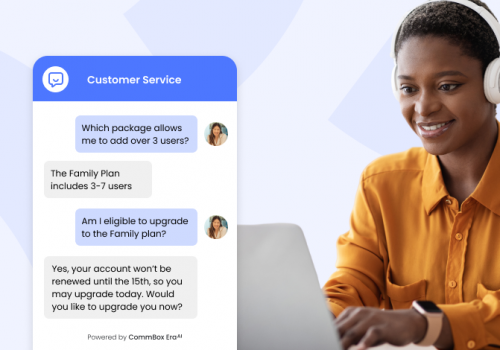Multi-Channel to Omnichannel. In this article, we are going to take you through the benefits of moving to an Omni-channel approach in case you are using a multi-channel business communication.
We will take a look into why it’s a great new approach for your company, the differences between multichannel and omnichannel approaches, benefits of using such an approach and some great ways to make sure you get the best out of your strategy.
Let’s start first by looking at the brief answer as to what an omnichannel approach actually means.
What is omnichannel? Omnichannel is a complete and holistic approach for customer communications through all channels. The approach is an improved version of the well known multi-channel approach that only allow communications through different channels without saving and maintaining customer data. The omnichannel approach provides with smooth and seamless communication through all channels and keeps all customer data inside the platform so the live agents can address their issues in an appropriate way.
Now that we’ve looked at the brief answer, let’s delve a little more deeply into this seamless customer service system.
What is omnichannel?
An omnichannel approach means there’s an integrated system that involves all elements of the retail oeuvres. Right from the distribution, promotion of the service or product and the communication channels on the back end of the system.
For example, previous purchases and preferences can be quickly and easily accessed by the customer service representative at the point of an in-store purchase, as seamlessly as any other service channel, such as a customer phone agent or even the representative who is responsible for web chat communication.
Seamless customer experience
Furthermore, the customer can also use a desktop computer to do a number of other processes, such as maybe checking the company’s website for inventories and then maybe purchase it later on their tablet or smartphone.
The process will then be completed by the customer being able to pick up their purchase at a location of their choice. Our own CommBox features modules that enable different channels to connect – to create a seamless integration for all your customer’s needs in one place.
Multichannel vs omnichannel.
A traditional multichannel retailer may have both a website and also a real-time physical location of their store. In the past, the two channels of the purchase were fairly isolated as far as processes were concerned, and there was very little interaction between the two.
Although both omnichannel and multichannel involve a process of selling across many physical and digital channels, the main differentiator is the manner in which the customer experience is joined across those channels.
Multi-channel gives a customer a ‘separate experience’
As a customer, your online interaction with the retailer is completely separated from your offline interaction. In essence, the online and offline channels are treated as separate businesses.
Usually on traditional multi-channel systems. Websites will have their own stock and stores will have a separate stock. In general, items that customers purchase in store can only be returned in-store and the same goes for website purchase.
Customers expect a single experience
However, today’s consumers are likely to have multiple touchpoints with a retailer and expect their customer journey between each touchpoint or channel should be seamless. So you should consider moving to an omnichannel experience.
They are not looking for two experiences they expect a seamless approach. In our digital world customers need to be able to interact on all levels with a brand and receive a cohesive experience. Whether a customer is in-store, on a mobile device or using their laptop at home, they are ever more increasingly expecting the whole journey to be unified.
“As a customer, your online interaction with the retailer is completely separated from your offline interaction. In essence, the online and offline channels are treated as separate businesses”.
Moving to Omnichannel
By leading your customers through a single channel, customers may be likely to move their custom elsewhere as constantly switching channels can be confusing and frustrating.
The key difference between multichannel and omnichannel is the way omnichannel activity joins the customer touchpoints together, so whichever route the customer takes along the purchasing journey, they receive a consistent and joined-up experience.
Now we’ve looked at how important it is to create a seamless shopping experience for your customers, let’s take a look at 3 great ways to make it work for your business.

3 great ways to get Omnichannel working for your business
Use analytics
With the addition of analytics, omnichannel retailing is able to obtain important insights into customer engagement, which is largely absent in multi-channel retailing.
These crucial analytics can enable businesses to target customers with the marketing message which suits their needs based on where they are in their buyer’s journey. Such targeted campaigns have higher conversion rates.
Getting insights on customer behavior is imperative for omnichannel success. A customer’s journey through both digital and physical channels has to be correctly analyses and accurately captured in order to deliver a more personalized shopping experience.
The other real benefit of such analytics is the ability of retailers to identify and Analytics also helps any important opportunities for up-selling, while also noting where customers aren’t engaging as much as they should.
Using Predictive analytics further expands on general analytics and can help to identify further trends in consumer behavior. This can ensure that retailers with omnichannel strategies stay on top of their game.
Product-Channel Sync
Often if one of your products isn’t selling as many units as you think it should be, it could be, there is a chance you could be selling via a channel that is not suited.
Once your product is on the right channel, it will be able to realize it’s full sales potential. It’s important that your product is on the sales channel that works best for its target customer, one which is used frequently by that demographic. For example, if you are marketing a product aimed at millennials, make sure you are focusing your efforts on your social media commerce channels in order to maximize sales.
Match characteristics to platforms
The characteristics of each product will also drive the platform it’s sold on. For example, if the chief selling point of the product is its visual appeal, then make sure it’s showcased on a platform where you can highlight this to the best advantage. Making use of your channels such as Instagram will bring you good returns.
To create the best omnichannel experience, build on that Instagram advertising from the promotion, marketing, and all the way through to the purchasing experience, in order to maximize its success.
Building on social media marketing and taking it through the website content, finally resulting in purchasing on mobile will ensure a seamless journey for your customer.
No specific channel
A good thing to remember is that although omnichannel marketing involves a consistent journey throughout the marketing and final purchase process, there is no single correct channel or channels to utilize.
One of the chief considerations when building your omnichannel strategy is to remember is to deliver content in terms of products, which are easily accessible across a multitude of devices.
It’s crucial you get the product-channel sync correct, in order to make your overall omnichannel strategy work in the most effective way.
Online versus offline
It’s also extremely important to remember that creating the most successful omnichannel strategy, you aren’t setting your online platforms against offline. Remembering not to try to score one against the other is important if you are looking to get the best out of your omnichannel strategy.
A situation known as In-store cannibalization can often be a huge concern for retailers with a bigger offline footprint. This can cause what Forbes magazine describes as an “omnichannel migration dilemma”.
A recent survey by HRC Advisory brought this issue to attention when it was discovered that nearly 75% of survey respondents reported that e-commerce transactions were stealing sales from storefronts and that E-commerce growth rates are surpassing brick-and-mortar sales by a substantial 10-15%
Most retailers including those with omnichannel strategies fail to strike a balance between in-store and online sales. That is because, they think omnichannel is all about customer experience and continue to look at online and offline as two disjoint channels, instead of leveraging one to support the other. For example, beacon technology can help retailers leverage mobiles to increase in-store sales.
“Remembering not to try to score one against the other is important if you are looking to get the best out of your omnichannel strategy”.

Barriers of an omnichannel strategy
One of the biggest barriers to the implementation of omnichannel is cost and complexity. A retailer with a physical presence is likely to already have a legacy in-store POS system that has been highly customized for them. Their order management and ERP systems are likely to be very bespoke and very highly integrated into their internal business systems.
There is a significant amount of investment required by companies in areas of technology and change projects. This technology will need to be integrated across the whole of the business and may even be required to replace some existing legacy systems.
This requires a whole vision and of course, commitment from the crucial company decision-makers. It’s a strategy that needs to be driven by the top management structures, in order for an omnichannel project to work best and be successful.
Availability of suitable technology
Although there is a wealth of sophisticated POS solutions available, many of them don’t offer enterprise web or mobile capabilities. There are many enterprise e-commerce platforms available, but many of them don’t have the capabilities to replace a POS in-store.
The many companies offering solutions can help a retailer make the important move towards omnichannel, however, many of the solutions available aren’t able to cover multiple significant areas of an omnichannel enterprise.
Culture
One of the biggest challenges a physical store retailer is likely to face when implementing an omnichannel strategy is the resistance from their staff in-store.
Unfortunately, staff often see the digital arm of the business as competition. With regards to sales staff, it can be difficult for them to embrace the new way of working mainly due to the fact that although they will get commissions in store, this won’t extend to the web platform.
Another large barrier to the adoption of omnichannel commerce is the culture of a business. As previously mentioned, the importance of this kind of strategy to be embraced from the boardroom downwards. It is crucial to the success of any kind of digital transformation that everyone from the directors to the floor staff adopt the new way of working into their roles.
“It’s a strategy that needs to be driven by the top management structures, in order for an omnichannel project to work best and be successful”.
The future of Omnichannel
Although there aren’t currently a huge number of retailers who have fully embraced the omnichannel medium, customer behavior and expectations and behavior of consumers will ultimately begin to drive brands to invest in the technology and change that is required.
Knowing exactly what a shopper is looking for will really help your business to target the right offers, to the right customer and crucially, at the right time. Using a single product like CommBox, with a modular approach to seamlessly connect all your relevant customer-facing channels makes sense.
To finish…
If you would like to speak to one of our expert team about how to build a successful omnichannel strategy using our CommBox software with seamless features, get in touch and we will make sure you keep ahead of the game. We’ll help you to develop a stellar strategy to make sure your company remains relevant within the extremely competitive retail arena.















